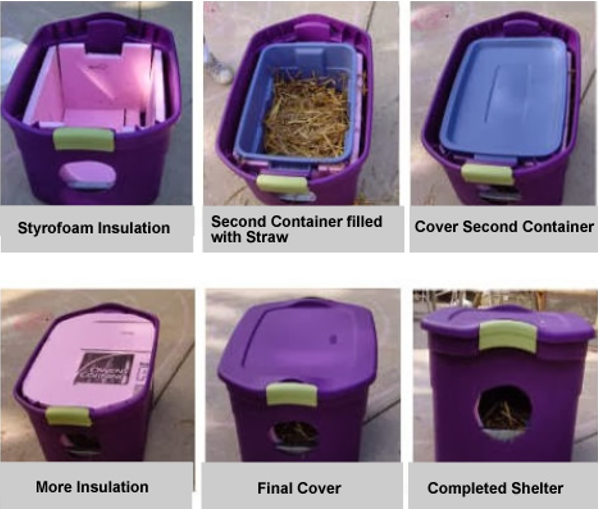How to Make a DIY Winter Shelter for Stray Cats
Winter can be an unforgiving season for stray cats, as they face the harsh realities of plummeting temperatures, icy winds, and limited food sources. Providing a winter shelter for these feline friends can make a significant difference in their survival and well-being. In this comprehensive guide, we will explore the essential steps and considerations involved in creating a safe and effective winter shelter for stray cats.
Before delving into the specifics of building a winter shelter, it's crucial to understand the unique needs of stray cats during the winter months. Stray cats lack the protection of a warm home and may struggle to find sufficient food, making them more vulnerable to the elements. A well-designed winter shelter can provide them with a refuge from cold weather, helping to prevent hypothermia and other weather-related health issues.
Choosing the right location for the winter shelter is paramount to its effectiveness. Look for a spot that provides protection from strong winds, precipitation, and direct exposure to the elements. Placing the shelter near a building or under an overhang can offer additional protection, ensuring the cats stay dry and warm.
Materials Needed:
Insulating Materials:
Straw: A highly effective insulator that retains warmth, straw is an excellent material for creating bedding inside the shelter.
Hay: Similar to straw, hay provides insulation and comfort. However, it can be a bit messier and attract pests, so use it cautiously.
Structural Components:
Styrofoam or Insulated Box: Use an insulated box as the main structure to provide a thermal barrier against the cold.
Plastic Storage Bins: Large plastic bins with secure lids can be repurposed to create a durable and waterproof shelter.
Tools:
Box Cutter or Utility Knife: Essential for cutting openings and shaping materials.
Duct Tape: Use duct tape to secure and reinforce the structure.
Building the Winter Shelter:
Prepare the Insulation:
Line the interior of the shelter with a thick layer of straw or hay to create a comfortable and warm bedding area.
Ensure that the insulation is tightly packed to prevent drafts and maintain warmth.
Construct the Shelter:
Cut a small entrance hole in the plastic bin, ensuring it is large enough for a cat but small enough to retain heat.
Place the insulated box or bin inside the plastic container, leaving enough space for the bedding material.
Add Final Touches:
Secure the lid of the plastic container to prevent water from entering.
Place the shelter in the selected location, ensuring it is stable and won't tip over.
Creating a winter shelter is just the first step. Regularly check and maintain the shelter to ensure its effectiveness. Replace bedding materials if they become damp, and monitor the overall condition of the shelter. If possible, provide additional food and water to support the cats' nutritional needs during the challenging winter months.
Building a winter shelter for stray cats is a practical way to help these animals survive harsh winter conditions. By understanding their needs, selecting appropriate materials, and following the guidelines provided in this comprehensive guide, you can make a positive impact on the well-being of stray cats in your community. Remember, a small effort on your part can make a significant difference in the lives of these vulnerable feline companions during the winter season.
Here are some more tips from first hand experience:
Camouflage: To enhance the shelter's blend with its surroundings, consider positioning it near natural elements like shrubs or bushes, providing an added layer of camouflage and protection for stray cats seeking refuge.
Multiple Exits: If feasible, incorporate more than one entrance/exit in the shelter's design. This approach not only prevents cats from feeling trapped but also offers them multiple escape routes, enhancing their sense of security.
Insulation Check: Regularly assess the condition of the insulation within the shelter to ensure it remains dry and effective against the harsh cold temperatures, maintaining a warm and snug environment for the cats.
Secure Placement: Anchor the shelter securely to the ground to prevent unintended tipping or displacement, especially during bouts of strong winds or inclement weather, ensuring the cats' safety and comfort.
Emergency Contacts: Display prominently nearby contact information for local animal control or rescue organizations. This facilitates immediate assistance in case of emergencies, fostering a proactive approach to the well-being of stray cats.
Educate Neighbors: Engage with your neighbors to create awareness about the presence of the shelter and emphasize its vital role in providing a safe haven for stray cats during the winter months, fostering a sense of community responsibility.
Regular Cleaning: Maintain a clean environment around the shelter by regularly clearing debris and waste. This not only discourages pests but also contributes to a hygienic space for the cats to seek shelter.
Strategic Location: Optimize the placement of the shelter by situating it near potential food sources, such as communal feeding stations or areas abundant in natural prey. This strategic positioning enhances the overall effectiveness of your efforts in supporting the cats.
Comfort Items: Consider adding a soft blanket or an old towel inside the shelter to provide additional comfort and warmth, creating a cozy retreat for stray cats seeking refuge from the cold.
Weatherproofing: Perform routine checks on the shelter's structural integrity before and after storms, ensuring that it remains weatherproof and secure. This proactive approach safeguards the shelter against the elements, maintaining a reliable sanctuary for stray cats throughout the winter.

